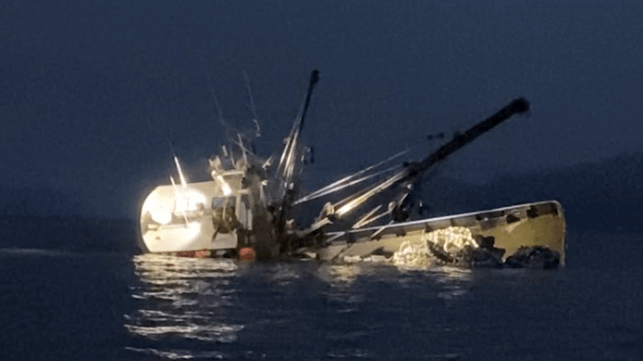NTSB: Master's Fatigue Led to Loss of Fishing Vessel off Whittier

The National Transportation Safety Board has released its report on the loss of the fishing vessel Tenacious, which ran aground and sank near Whittier, Alaska last year. According to NTSB, fatigue was the primary cause of the casualty.
In the early morning of July 24, 2021, at about 0330 hours, the purse seiner Tenacious went aground about 14 miles east of Whittier, Alaska. The crew was on the way to fishing grounds in Prince William Sound after a sprint to get ready for a season opener. All five crewmembers abandoned ship into the vessel's skiff and were safely rescued by a good samaritan vessel. The Tenacious and the 2,000 gallons of diesel fuel in her tanks were never recovered.
On July 23, Tenacious berthed at Whittier to fix some maintenance problems with her seine skiff. The crew needed to get the work done in time to be on station for a pink salmon opener in Prince William Sound on July 24. The skiff could not be repaired, so three members of the crew drove to Seward to borrow another one, a round trip of about four hours. This delayed the vessel's departure from Whittier until early the next morning and prevented the crew from getting a night's sleep.
Tenacious got under way from Whittier at about 0130 hours on July 24, bound for the south end of Culross Island. According to the deckhand, the whole crew had had "not too much sleep" after the events of the previous day. The captain told NTSB that "everybody was pretty well tired," and he had been awake continuously since 0800 on the day before.
The captain took the first watch after departure and let the rest of the crew rest. Shortly before 0330, the vessel struck a rocky shoal off the tip of an unnamed peninsula at Wells Pass. He backed down to get off the rocks, and the vessel began going in circles. On checking the engine room, he found that it was flooding from several penetrations, and he was forced to leave the compartment when water reached an electrical panel.
The vessel's owner was on board, and he went to the bridge and made a distress call. He perceived the danger from the rising water, and he ordered the crew to get into the skiff. The captain joined them and they abandoned ship. The Tenacious rolled to port and sank as they watched.
A nearby fishing vessel heard the distress call and reported to the Coast Guard that all crewmembers were safely aboard the skiff. A search and rescue mission was called off, and a good samaritan vessel picked up the survivors at about 0645.
After the casualty, the master told NTSB that he had slept poorly for days and had "nodded off" during the transit that night. He took full responsibility for the casualty.
"I knew everybody was tired and wore out and I knew I was too, but . . . I also knew there was lots of fish around, boat loads, so that probably had a lot to do with my decision," he said.
The chart plotter's cross check error alarm was not engaged on the casualty voyage, nor was the bridge watch alarm - contributing factors in the casualty, NTSB concluded.
"Given the captain’s extended awake hours, operating outside of his typical work/sleep schedule, bad quality of sleep on previous nights, and reduced performance from the circadian low [on the midwatch], it is likely the captain was impaired by both acute fatigue and a chronic sleep debt resulting from reduced sleep quality in the preceding days," wrote NTSB. "As found in other NTSB investigations, the structure of this [opener] fishery encouraged working longer hours to increase the vessel’s portion of the catch, which leads to a fatigued crew."
NTSB also noted that the Tenacious did not have (and was not required to have) a watertight bulkhead between her engine room and her bunkroom. If she had been built with a watertight bulkhead, she might have maintained enough reserve buoyancy to remain afloat after the grounding, NTSB concluded.

that matters most
Get the latest maritime news delivered to your inbox daily.
Fatigue is a long-running safety issue in the Alaska fisheries. Other accidents that were attributed to crewmembers working long hours without rest include the grounding of the Savannah Ray in 2015 and the St. Dominick in 2017, both in Alaskan waters.
According to the NTSB, there have been 805 fatalities, 164 missing and 2,122 people injured in commercial fishing vessel accidents in the U.S. over the past two decades.
